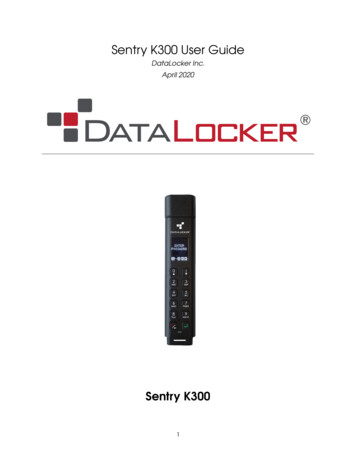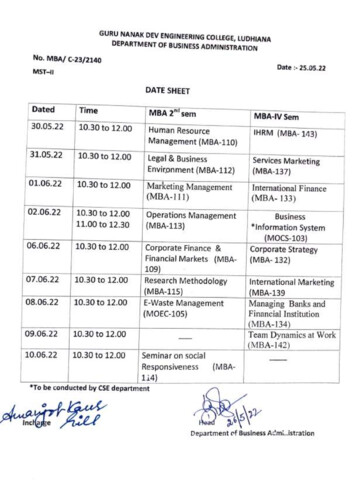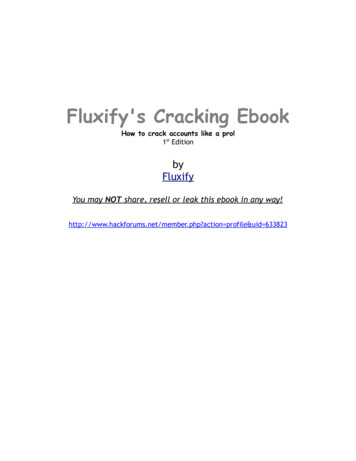
Transcription
Sentry MBAA Tale of the Most Widely Used Credential StuffingAttack ToolReport by Danna TheeCyberInt Threat Intelligence ResearcherBuild a Better Sandcastle: Hack-Proof Security with Cyber Intelligence
Table of ContentsIntroduction2What is Cracking?3Credential stuffing attack4Sentry MBA Cracking Tool5Anatomy of Credential Stuffing Attack Executed by Senty MBA7Sentry MBACredential Stuffing Attack Detection8Suggested Mitigation Steps9Hacking in the Age of Social Media10Build a Better Sandcastle: Hack-Proof Security with Cyber Intelligence
IntroductionEvery so often security breaches and compromised accounts are reported in the news.Some data breaches are disclosed to the public long after the act; others are not even reported.Large data breaches generally are focused on very large organizations, which have becometargets for threat actors. However, organizations of all sizes are affected by data breaches.But how can organizations better prepare for and mitigate against such events?Compromised credentials are not a new phenomenon, but the frequency of such instances hasincreased. The number of compromised credentials available online is staggering, providinga goldmine for attackers. Of confirmed data breaches, 63% involve weak, default or stolenpasswords. At all times, users’ credentials are being sold, traded and shared online across theInternet: hacking forums, online marketplaces, paste sites, and of course, on the Dark Web.This report describes the Sentry MBA, a credential stuffing attack tool, which has become themost popular cracking tool among threat actors in recent months. Among the reasons for itspopularity, the Sentry MBA hacking tool is freely and publicly available, extremely effective,and easy to operate.In a credential stuffing attack, large numbers of stolen credentials are automatically testedagainst a web application's authentication mechanism until a match with an existing account isfound. The attack technique relies on weak passwords and password reuse as it uses previouslyleaked credential combinations as part of its attacks.It is important to note that not all industries are affected in the same way by this type of attack.The top three industries affected are technology, entertainment and financial services.This report seeks to help organizations understand where they are exposed, how threat actorsare using this information, and what they can do to prepare for and mitigate such events.This report describes the SentryMBA, a credential stuffing attacktool, which has become the mostpopular cracking tool amongthreat actors in recent ights-lab/dbir/2016/Build a Better Sandcastle: Hack-Proof Security with Cyber Intelligence2
What is Cracking?In the security industry, the term cracking refers to the malicious act of obtaining unauthorizedaccess into someone’s computer system without his permission and knowledge. Contrary to thewidespread terminology, cracking does not usually involve extensive hacking knowledge andcapabilities, but rather persistence and dogged repetition of handful tricks that exploit commonweaknesses in the targeted system.Hackers conceive crackers as less educated hackers, and refer to them as “script kiddies”or “newbies”, because they do not create their own attack tools, but instead they steal orpurchase cracking tools for malicious intent or personal gain. Although the number of crackersis numerous, they are generally easier to stop and identify. Sentry MBA is an example of a verypopular tool among crackers because it is free and considered to be very effective.Figure 1 below shows a discussion on an underground Dark Web forum about the essence ofcracking. A threat actor identifies himself as “MysticRabbit1” was in search after cracking lessonsor tips. In reply, one threat actor identifies as “v4grant” refers to cracking as an action focusing onobtaining users credentials. Another threat actor that calls himself “panic” refers to sentry MBAas a cracking tool by claiming that cracking takes advantage of the fact that people commonlyreuse their passwords on multiple websites, and that the tool tests username/passwordcombinations against other websites.Figure 1: Dark web discussion about the essence of cracking.Build a Better Sandcastle: Hack-Proof Security with Cyber Intelligence3
Credential stuffing attackCredential stuffing (OWASP OAT-008) is the automated injection of compromised username andpassword pairs in order to accomplish account take-overs. Large numbers of stolen credentialsare automatically tested against a web application's authentication mechanism until a matchwith an existing account is found. Then the attacker can hijack the account for diverse purposes:drain the account of funds, steal personal identifiable information, spread spam and phishing, orinstall C2 malware or keyloggers.Although the credential stuffing technique is referred to as a type of brute-force attack, theattacker does not guess at values; Attackers using the credential stuffing technique instead relyon weak passwords and password reuse and uses previously leaked credential combinations.These credentials pairs, known among threat actors as "Combos" or "Combo List", are regularlyobtained from breaches on other websites that are sold on underground forums or marketplacesor may be available on public sites like Pastebin.Sentry MBA exploits the improper control of interaction frequency and the improperenforcement of a single, unique action, meaning Sentry MBA is relying on the lack of restrictionsagainst automated attacks such as credentials stuffing. This vulnerability is also known asInsufficient Anti-Automation Vulnerability, which occurs when a web application permits theattacker to automate a process that was originally designated only for manual users.According to OWASP, credential stuffing is an emerging threat as it is one of the most commonattacks on web and mobile applications today and is capable of breaching sites that do not havewhat are considered to be traditional security vulnerabilities. These attacks will put at risk bothconsumers, as the compromised account owners, and organizations, as the web applicationprovider.Credential stuffing technique relies on weak passwordsand password reuse and uses previously leaked credentialcombinations that are automatically tested against a webapplication's authentication mechanism until a match withan existing account is foundBuild a Better Sandcastle: Hack-Proof Security with Cyber Intelligence4
Sentry MBA Cracking ToolThere are many credential stuffing tools, though in recent months Sentry MBA has emergedto become the most popular. Among the reasons for its popularity, Sentry MBA is a freely andpublicly available modular software with a nice user interface. Additionally, the tool is extremelyeffective because it’s common for people to use the same credentials on multiple applications.Even though Sentry MBA is commonly used and has high success rates (usually 0.1%-0.2% of thetotal login attempts), our customers were generally not aware of its existence. Not only werethey not familiar with the attack technique and the tool used to execute it, they were not able todifferentiate attacks from regular login activities.Below, Figure 2 shows a screenshot of the main interface of the Sentry MBA tool, which is astandalone Windows application.Figure 2: Sentry MBA main interface.Build a Better Sandcastle: Hack-Proof Security with Cyber Intelligence5
Three vital components are needed to execute a credential stuffingattack using the Sentry MBA tool:The configuration file, also known as “Config file”, enables Sentry MBA to properlynavigate in the targeted online login portal by defining the unique parameters ofeach web page.Proxy file is a list of compromised hosts (usually compromised endpoints or bots)that Sentry MBA uses during the attack. Proxies help the attacker evade websitedefenses by spreading login attempts across many sources.Combos list contains numerous username/password combinations from previousleaks that will be tested against the target's authentication mechanism.Cracking communities offer a wide range of these sentry MBA components for various websites.Sentry MBA has functions to mitigate traditional online login form security controls, such as IPrate limits and blacklists, as well as the capability to bypass third-party security controls that atargeted website might use. For example, if a site has a CAPTCHA mechanism implemented, SentryMBA attempts to bypass it by using Optical Character Recognition (OCR) software, like Death byCaptcha API, so that it can read and solve CAPTCHA challenges.In most cases, threat actors are using Sentry MBA for a credential stuffing attack. But in some cases,attackers use the Sentry MBA in DDoS attacks when run at a high rate. d a Better Sandcastle: Hack-Proof Security with Cyber Intelligence6
Anatomy of Credential Stuffing AttackExecuted by Sentry MBAFigure 3 is a visual representation of what happens during a Sentry MBA attack. An attacker takesthe following steps to make an attack using Sentry MBA:The threat actor obtains dumps of leaked credential combinations from paste sites, filesharing sites or underground marketplaces.The threat actor uses the Sentry MBA tool to test the credential combinations against thetarget’s online login web page.Successful logins allow the attacker to take over the account matching the stolencredentials.The threat actor drains stolen accounts of stored value, credit card numbers, and otherpersonal identifiable information.The threat actor can then either make a profit by selling the stolen account information oruse it for other malicious intentions.Figure 3: Credential Stuffing attack diagram by OWASP.3https://www.owasp.org/index.php/Credential stuffingBuild a Better Sandcastle: Hack-Proof Security with Cyber Intelligence7
Sentry MBA CredentialStuffing Attack DetectionBy default, Sentry MBA uses the following user agent strings:Mozilla/4.0 (compatible; MSIE 7.0; Windows NT 6.0; .NET CLR 1.1.4322; .NET CLR 2.0.50727; .NETCLR 3.0.4506.2152; .NET CLR 3.5.30729)Mozilla/4.0 (compatible; MSIE 8.0; Windows NT 6.1; .NET CLR 1.1.4322; .NET CLR 2.0.50727; .NETCLR 3.0.4506.2152; .NET CLR 3.5.30729)Mozilla/5.0 (Windows; U; Windows NT 5.1; en-US; rv:1.9.0.11) Gecko/2009060215 Firefox/3.0.11Mozilla/5.0 (Windows; U; Windows NT 5.1; en) AppleWebKit/522.11.3 (KHTML, like Gecko)Version/3.0 Safari/522.11.3Opera/9.80 (Windows NT 6.0; U; en) Presto/2.2.0 Version/10.00If you find these user agent strings in your web logs, it’s likely you have been compromised bya credential stuffing attack. The OWASP Automated Threat handbook notes that you shouldobserve a high authentication failure rate when a credential stuffing attack is taking place. Theterm “high” is left to interpretation, but it’s fair to say that any authentication failure rate that ismultiple standard deviations beyond the mean for your website qualifies as “high”.If you decide to blacklist these User Agent strings, you should recognize that these strings can bechanged by an attacker to bypass such a control. Before you take any action, we recommend youconsider the associated game theory.Build a Better Sandcastle: Hack-Proof Security with Cyber Intelligence8
Suggested Mitigation StepsSecure your system to mitigate credential stuffing attacks:Monitor the system for systematical attempts to query the database from the same HTTP client(based on IP, User Agent, device, fingerprint, patterns in HTTP headers, etc).Implement an anti-automation mechanism, such as CAPTCHA or two-factor authentication, onvulnerable requests: login, registration, password reset, etc.Limit the number of accounts that can be registered from one IP address in a certain period of time.Limit the number of login attempts per HTTP client.Document and monitor all user login actions.Define the measures that would be taken in the event that a credential stuffing attack occurs.Use threat intelligence services to detect potential or real-time credential stuffing attacks.Restricting automated process by one of the following:FingerprintingReputable methods such as geo-location and/or IP address block listsBuild a Better Sandcastle: Hack-Proof Security with Cyber Intelligence9
Hacking in the Age of Social MediaWe are accustomed to threat actors using social networking sites as a tool to target organizationsor people for the means of getting vital information and data about the targets. But threat actorsalso take advantage of direct communication between individuals and easy access to the wisdomof the crowd. They use social networks to gain knowledge on attack techniques and tools andalso to share data leakages, brag on their successes and share their experiences.While we used to think that hacker activity goes under the radar in underground forums,marketplaces or the Dark Web, in the age of social media hacking and cracking communities arethriving out in the open, sometimes by using a fake identity, but often with their real names.Thus, information on how to use Sentry MBA is not hidden in an underground Dark Webcommunity. In fact, a simple search on YouTube will show dozens of how-to videos, and a quicksearch on Twitter or Facebook will reveal threat actors sharing their Sentry MBA “config” filesor a dump of stolen credentials. Figures 4-10 show real examples, taken from online sources, ofhow threat actors interact online and share information regarding Sentry MBA and compromisedcredentials.Figure 4: Screenshot from an online Sentry MBA tutorial on YouTube.Figure 5: Screenshot from a threat actor guide on how to use Sentry MBA interface.Build a Better Sandcastle: Hack-Proof Security with Cyber Intelligence10
Figure 6: “Sentry MBA Team” crackers group offering Steam config filefor sale on Facebook.Figure 7: Twitter config file for Sentry MBA is offered for sale on Facebook.Build a Better Sandcastle: Hack-Proof Security with Cyber Intelligence11
Figure 8: Threat actor identified as “Glen Sentry” shared Instagram and Amazon config filesfor Sentry MBA on Facebook.Figure 9: A threat actor identifies as "Jayvioun Warren" offers a combolist of67,000 Instagram users for sale for 40 on a Facebook group.Figure 10: Threat actor posted a dump of 15 username/password pairs.Build a Better Sandcastle: Hack-Proof Security with Cyber Intelligence12
United KingdomTel: 442035141515 sales@cyberint.com25 Old Broad Street EC2N 1HN London United KingdomUSATel: 972-3-7286-777sales@cyberint.com3 Columbus Circle NY 10019 New York USAIsraelTel: 972-3-7286777 Fax: 972-3-7286777sales@cyberint.comHa-Mefalsim 17 St 4951447 Kiriat Arie Petah Tikva IsraelSINGAPORETel: 65-3163-5760sales@cyberint.com10 Anson Road #33-04A International Plaza 079903 SingaporeBuild a Better Sandcastle: Hack-Proof Security with Cyber Intelligence
attackers use the Sentry MBA in DDoS attacks when run at a high rate. The configuration file, also known as "Config file", enables Sentry MBA to properly navigate in the targeted online login portal by defining the unique parameters of each web page. Proxy file is a list of compromised hosts (usually compromised endpoints or bots)










